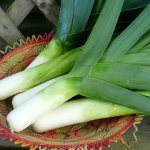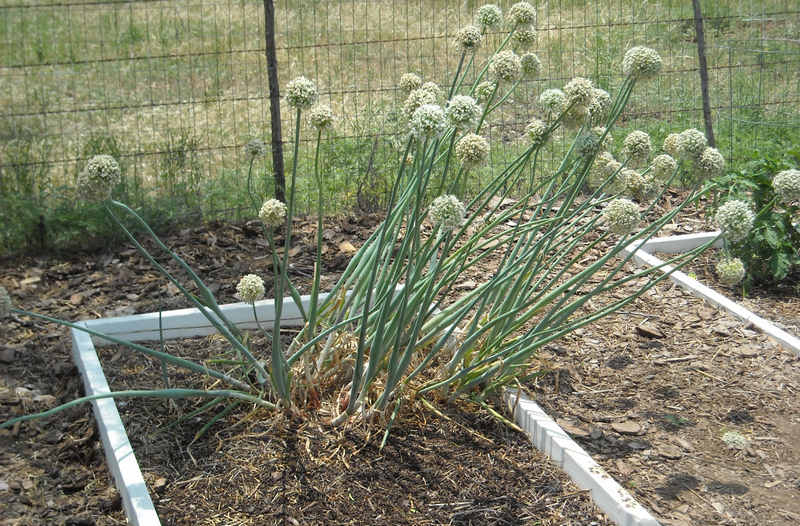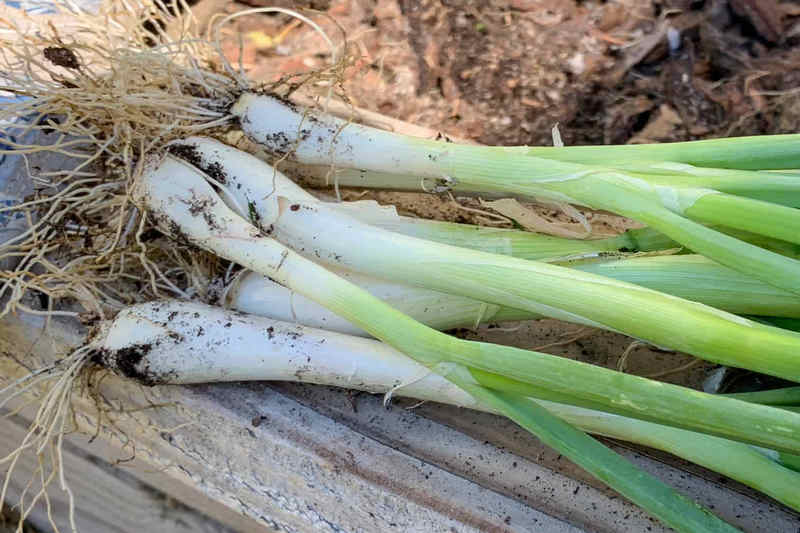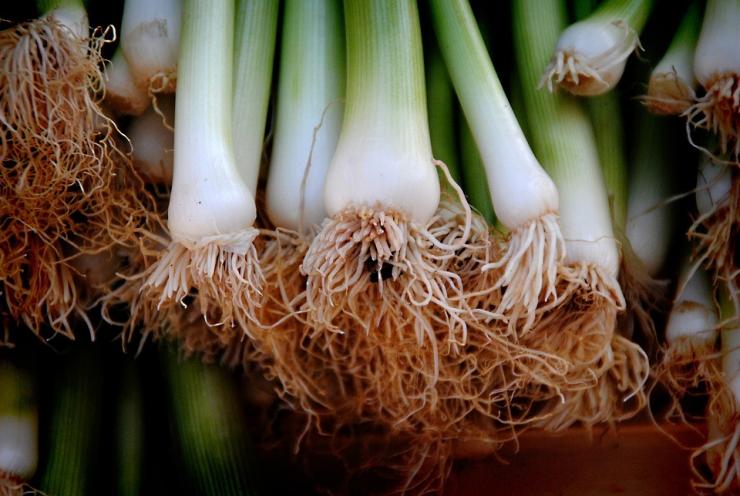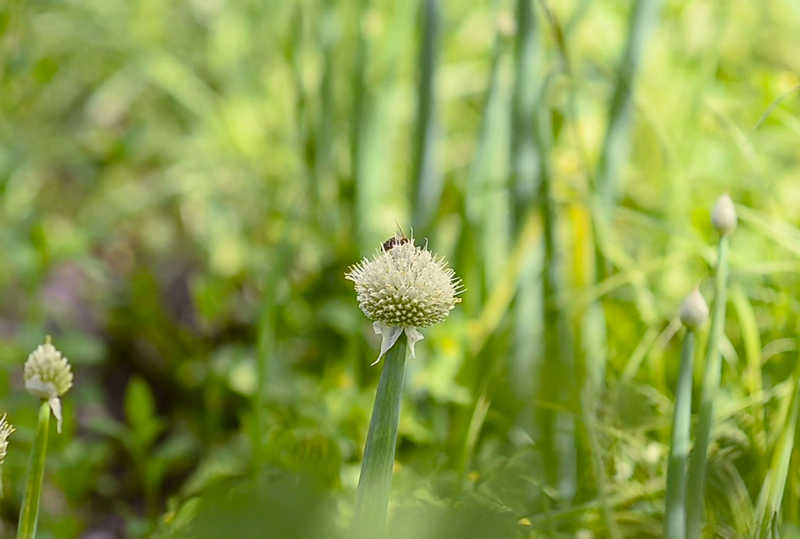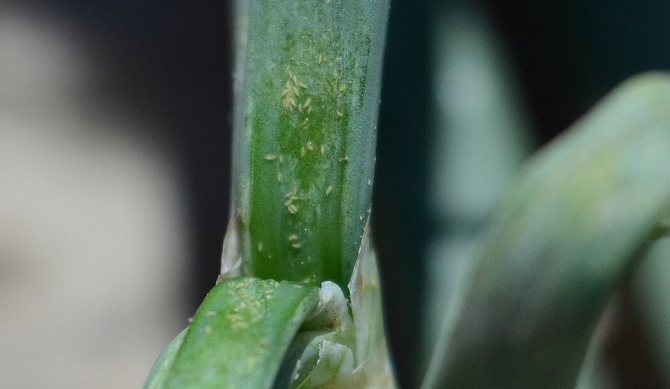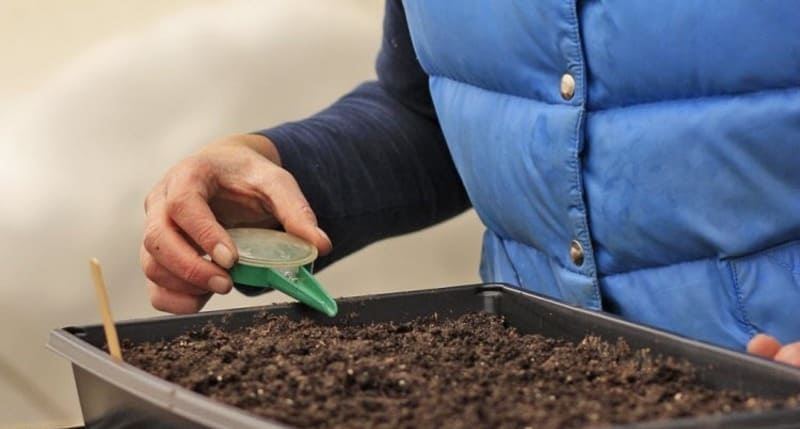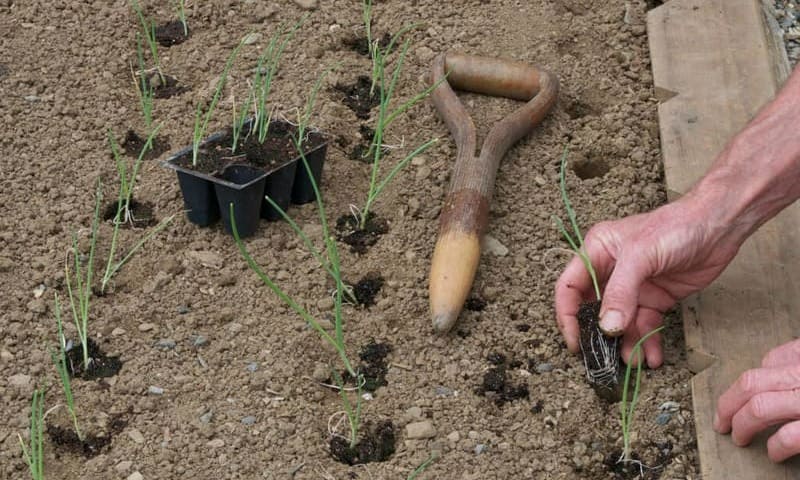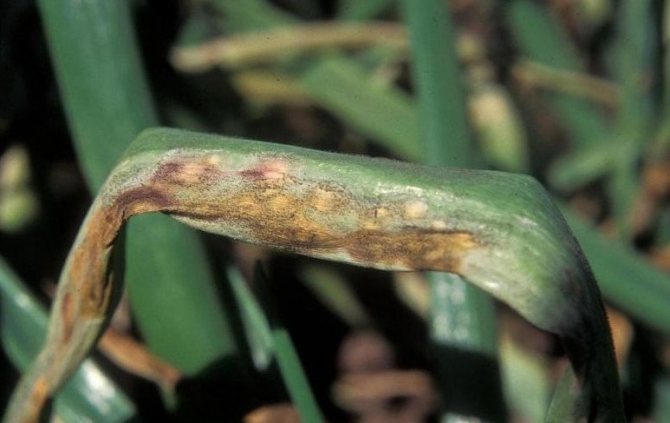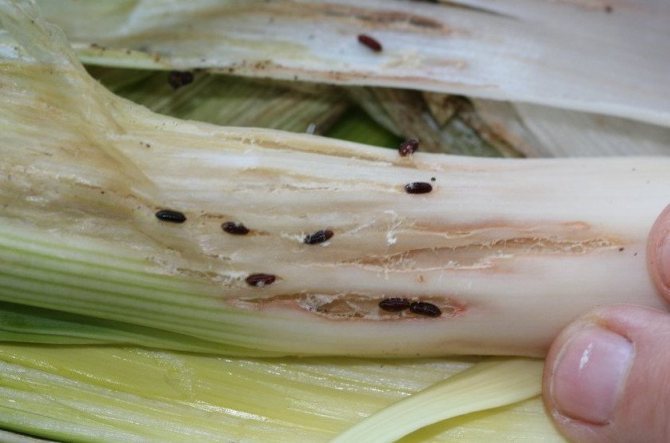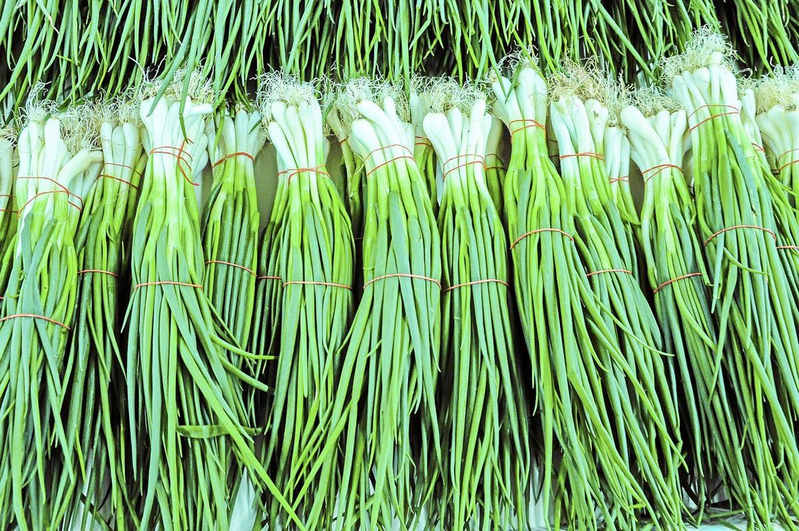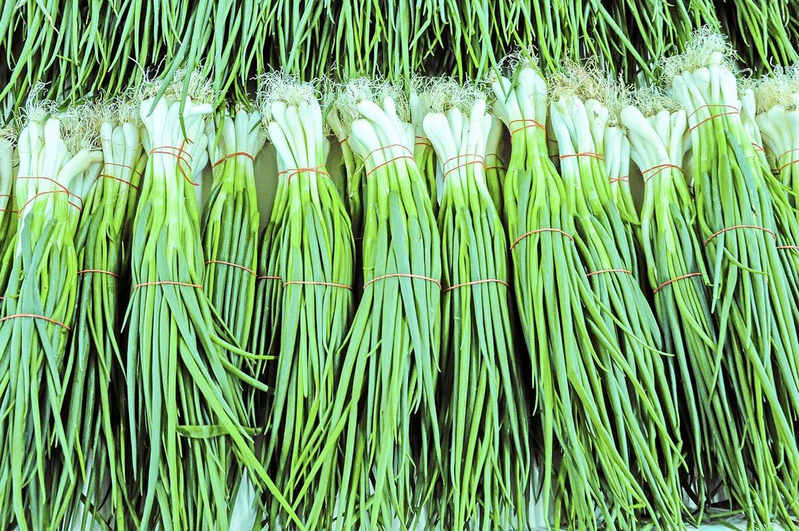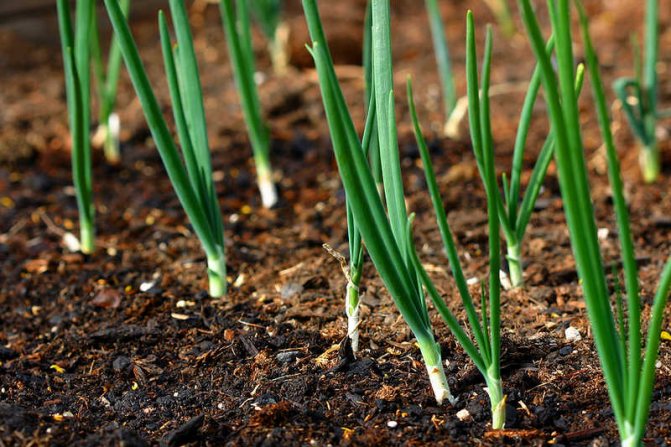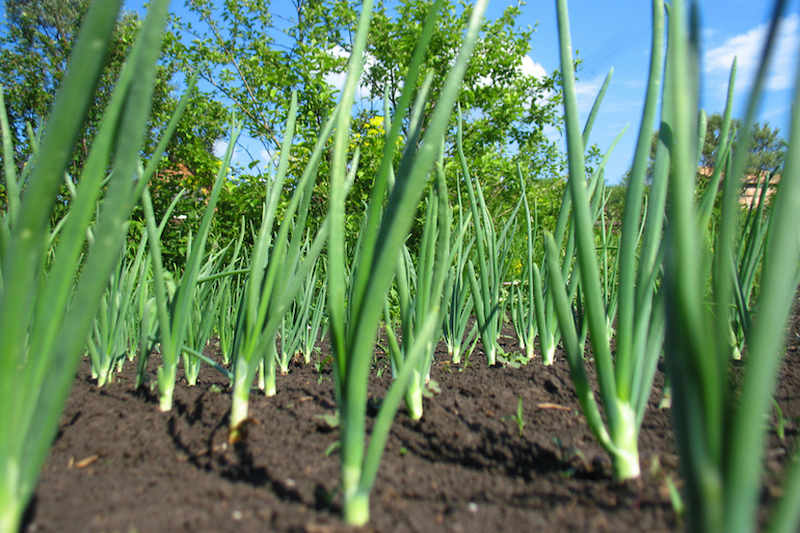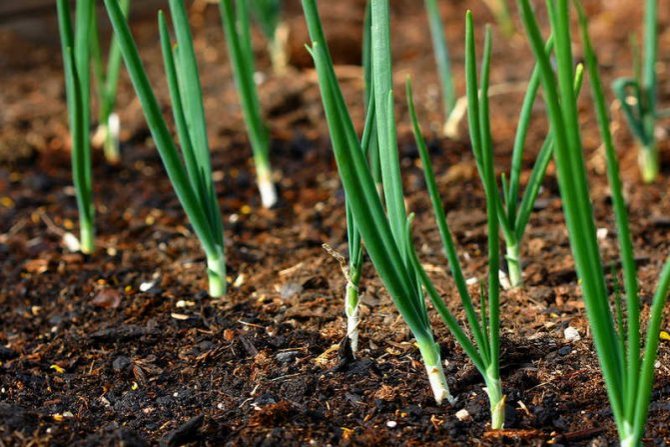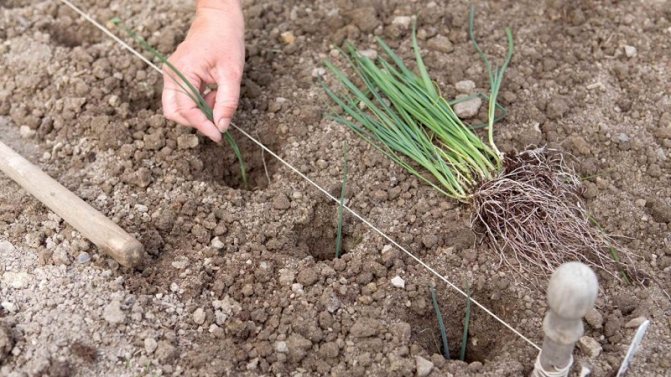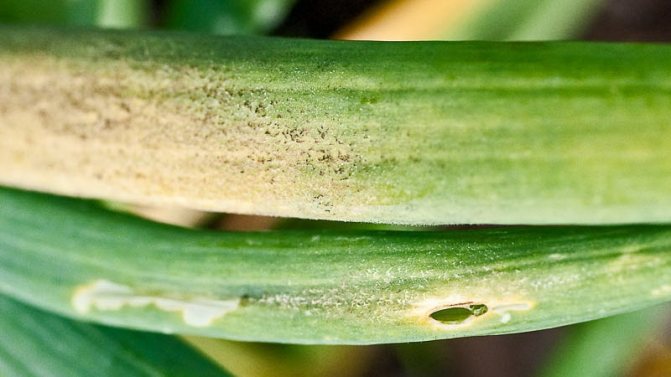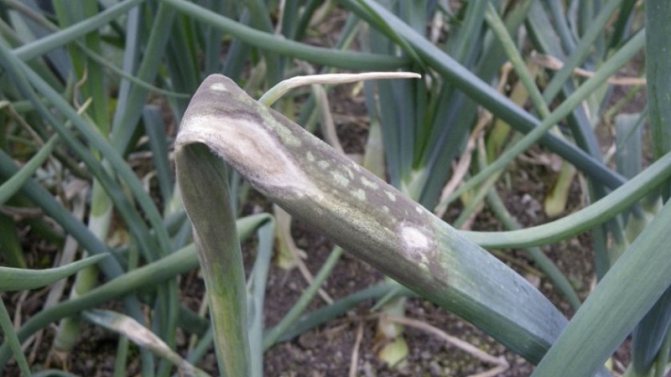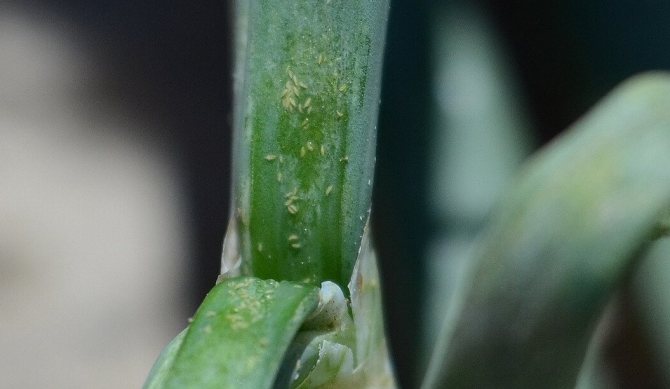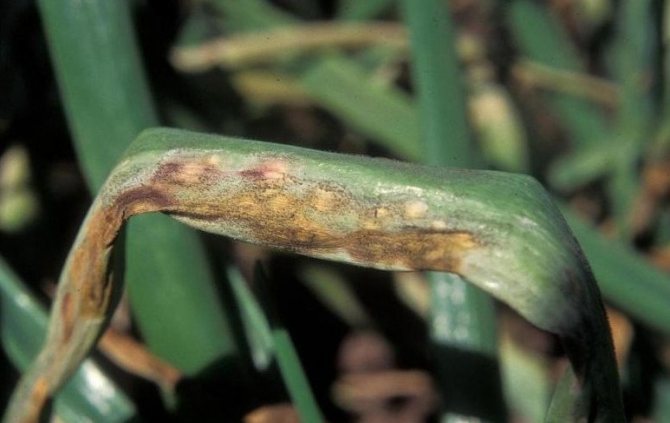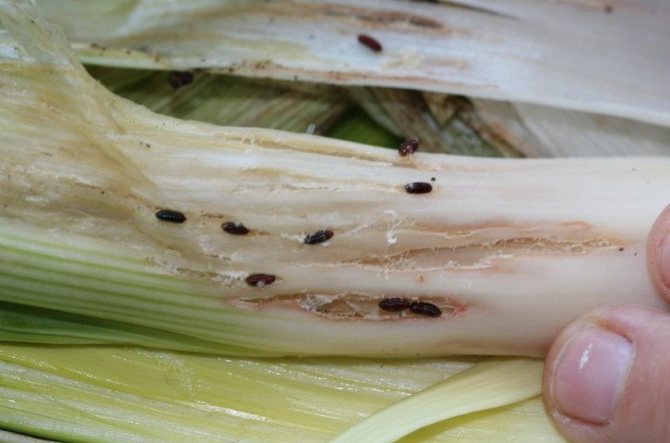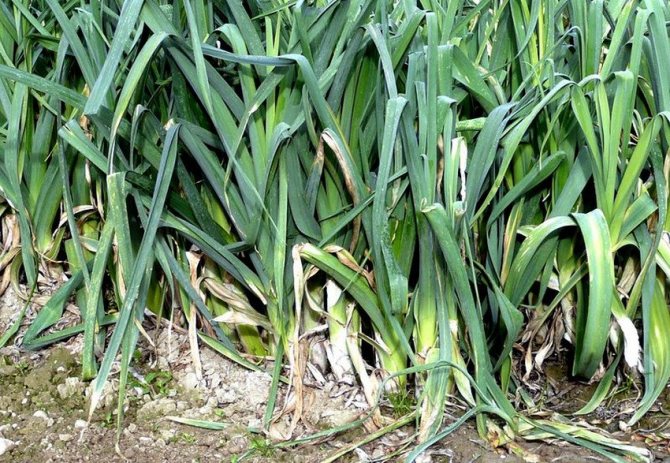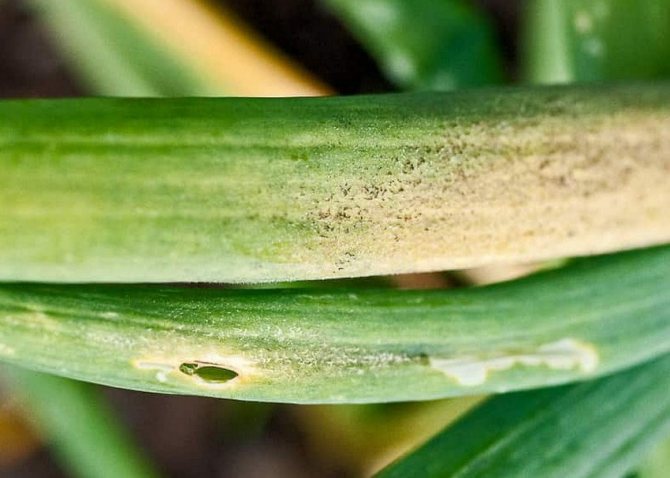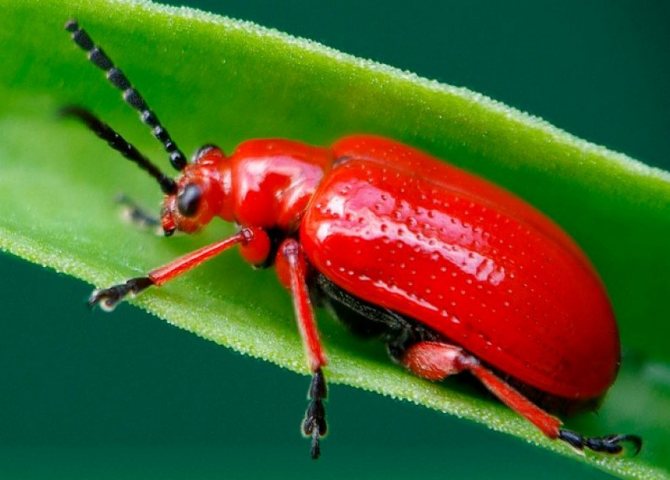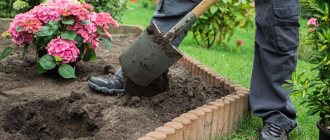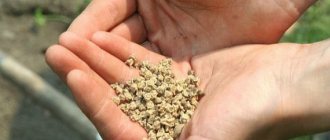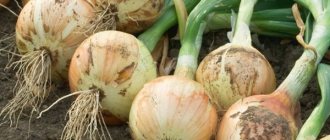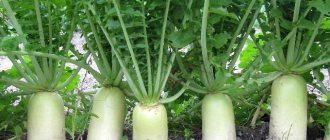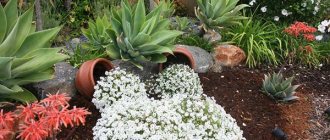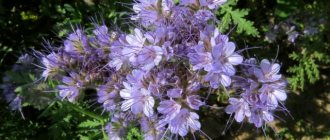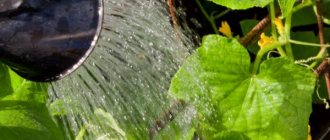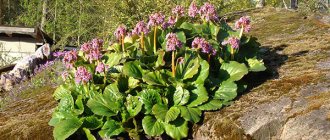Some summer residents believe that to grow onion much lighter than leeks. However, it is worth knowing that the gastronomic qualities and rich vitamin composition of leeks are significantly superior in their subtlety of taste (not spicy, but even slightly sweet) to their onion counterpart. Nevertheless, even a novice summer resident can plant and grow leeks on his site, which you will definitely see by reading this material to the end.
What does a leek look like: photo
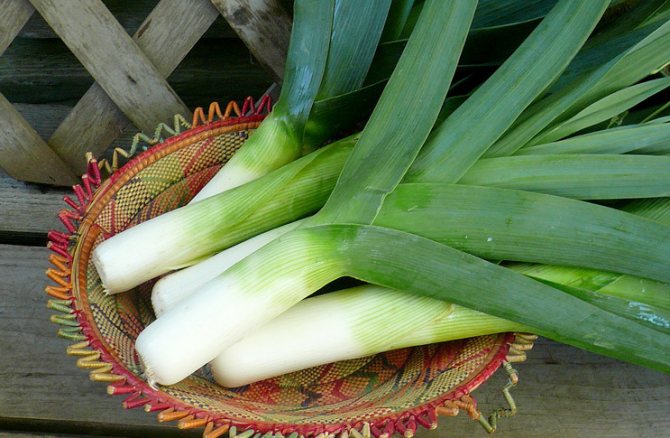
Leek: photo
Leeks are a fairly tall green plant that looks very different from the onions we are used to. It does not have a large, rounded bottom. Rather, it is, but less pronounced and has an oblong rather than round shape. A massive white stem emerges from the top of the false bulb. As a rule, its thickness is almost the same as the size of the false bulb. The stem ends with a fan-shaped bunch of long green leaves. You can see what the leek looks like in the photo located a little higher.
Treatment of leek seeds before planting: description
Experienced gardeners know that absolutely all seeds need to be prepared for sowing as this contributes to their faster germination and rooting. Leek seeds are no exception and are also best prepared properly.
So:
- First, boil the water and then cool it down to 45 degrees
- Fold the seeds in a piece of gauze, tie it into a kind of bag and immerse it in warm water for 25 minutes
- After that, we dip the seeds in cool water and lay them on a damp cloth.
- Cover them with another piece of cloth and leave them alone for 3-5 days.
- Remember to periodically dampen the cloth with a spray bottle
- After the specified time, the seeds will be ready for sowing.
- If you wish, you can additionally treat them with growth stimulants and disinfect them in a weak solution of potassium permanganate
When to plant leeks for seedlings: planting time
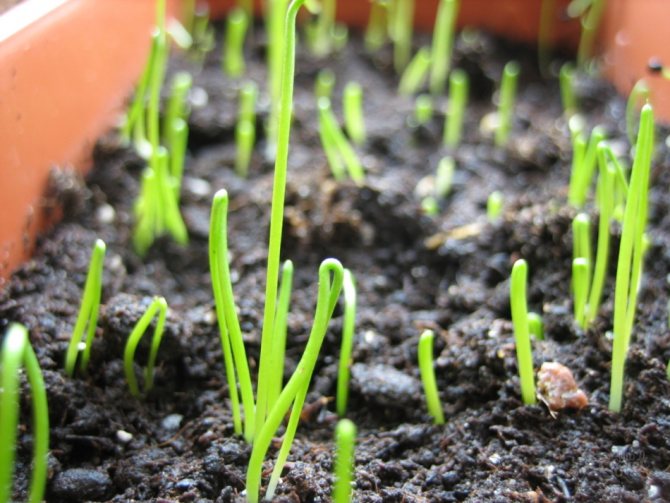

Leek seedlings
If you want to grow leek seedlings from seed, then remember that this plant has a fairly long growing season. Depending on the variety, it can range from 4 to 6 months. This nuance must be taken into account, especially if you live in a region with a colder climate.
If you start growing seedlings later than necessary, you risk not getting a good harvest. In order for even late-ripening leek varieties to ripen before the cold weather, it is necessary to sow seeds for seedlings in mid-February or early March.
Variety selection
Leek varieties are divided according to the ripening period.
You can learn more about the varieties of leeks from the article: 20 varieties of leeks for the Moscow region, the Urals and Siberia, north-west and central Russia in terms of ripening
1. Early maturing
Columbus, Vesta, Elephant Trunk, Tango, Kilima, Shelton, Goliath
Ripening occurs at the end of August. The onion of this variety is almost straight in shape, the leaves are located very close to the stem. A distinctive feature of the early variety is the looser arrangement of the leaves of the plant. Another feature is poor tolerance to cold temperatures.Therefore, this culture is cultivated in the southern regions, which makes it possible to grow leeks in a seedless way, sowing seeds directly into the soil.
Sowing leek seeds for seedlings
IMPORTANT: Before you start sowing leek seeds for seedlings, carefully prepare the soil and containers in which they will germinate. Both the soil and the container must be disinfected with any means available to you, and only after that you can proceed to further work.
Recommendations for sowing leek seeds for seedlings:
- First, mix the soil with fertilizer and slightly moisten it.
- Place it in a disinfected box and compact slightly
- This must be done so that there are no voids in the soil that will prevent the seedlings from rooting.
- Further, in the ground we make not very deep grooves literally 2 cm deep
- We sow leek seeds in them, sprinkle them with soil, moisten it from a spray bottle and cover everything with a film
- The seeds sown in this way must be placed in a warm place.
- The room must be kept at a temperature of at least +20
- After the shoots appear, the seedlings are removed to a cooler place and their hardening begins.
- To do this, remove the film from the box and begin to gradually reduce the temperature in the room.
- In order for the seedlings to feel comfortable, every day the temperature indicators should drop by 1 degree.
- When the temperature drops to 14 degrees, hardening stops
When to sow
The vegetative period of plant growth is about 200 days. So when should you be sowing?
It is necessary to take into account the following conditions to create favorable conditions: 1. Traditionally, leeks are sown in the last days of February, then by September the useful culture will have time to ripen. Seedlings can also be planted in the greenhouse, thus creating better conditions. 2. If the plants are planned to be grown in the beds, then it is necessary to start planting in the last days of March. 3. If the climate is colder, then it is allowed to sow seeds during April, and prepare for transplanting seedlings in the middle of the first summer month. Leek seedlings will have to be planted in Siberia, unfavorable weather simply will not allow starting work ahead of schedule, since the soil has not yet warmed up enough. Moon calendar will help you choose the most favorable days for sowing and planting young shoots.
It's important to know! If sowing seeds for seedlings is planned for the spring, then it is recommended to take early ripening plant varieties, which will be the guarantor of a ripe harvest in time
Soil preparation
To grow seedlings, you need to prepare the soil in a special way. For this, the nutrient mixture is prepared by combining the following components in equal proportions: • turf soil; • compost; • humus; • peat. The soil is filled with substances useful for seeds and turns out to be rather loose. Leeks are sown in peat, but then a special composition is made: peat, garden soil and humus are mixed in a ratio of 1: 1: 2. Attention! Fresh organic matter - manure and mullein - can greatly harm or destroy plants.
Choice of capacity
Onion seedlings do not tolerate the picking process well, so the choice of a suitable container is an important point. For planting, containers are suitable, the depth of which will be 12-15 cm, leeks grow long roots. The prepared container is pretreated with a solution of potassium permanganate for its disinfection and dried.
Seed preparation for sowing
To obtain high-quality seedlings, you need to prepare:
- Pack the seeds in a linen or cotton bag and dip in a light solution of potassium permanganate for 30 minutes.
- Then hold the bag in clean cold water.
- Put the seeds on a damp cloth and cover with a thin layer of cloth on top, leave for 7 days.
- Dry them and go to sowing work.
Sowing seeds
- The disinfected container is filled with previously prepared soil, tamped a little and watered.
- In containers or boxes, grooves are marked about 5 cm from each other, the seeds are placed at a distance of 3-4 cm from each other. If onions are sown directly into individual cups, then the seeds are placed in the soil to a depth of 1–1.5 cm,
- From above, carefully watered so as not to wash out the newly planted seeds. After that, the container with crops is covered with a transparent film, which will help create a greenhouse effect.
- Leek sprouts need good lighting and warm air (22-25 degrees). The best location in the house will be a windowsill, where there is always a lot of light.
- Sometimes the film needs to be lifted to moisten the soil and ventilate.
- After the appearance of the first shoots, after about 14 days, the film is removed. Now the temperature should be lowered to a comfortable 17 degrees during the day, and at night - no more than 12. This approach does not allow the plants to stretch. After a week, the seedlings can be returned back to a warm place.
- Care should be taken when watering so that stagnant water does not form in the soil. Otherwise, it will not be possible to avoid damage to the roots by the black leg.
Growing seedlings in a snail
Interesting! There is another, not such a new way of sowing seeds, namely growing leek seedlings in a snail.
You will need transparencies up to 10 cm high, toilet paper or soil, and a container of a suitable size.
- Spread a thin layer of soft paper or soil onto the film layer and place the seeds at a distance of 1.5–2 cm from the top edge.
- After that, the film with such filling is tightly rolled into a roll resembling a snail in shape. The bottom edge of the resulting tube is dipped into a container with a small amount of water.
- As the onion grows, the roots of the onion will lengthen to the very bottom of the container.
- This planting saves space, you don't have to think about where to put boxes with seedlings. Soil consumption for sowing is also significantly reduced.
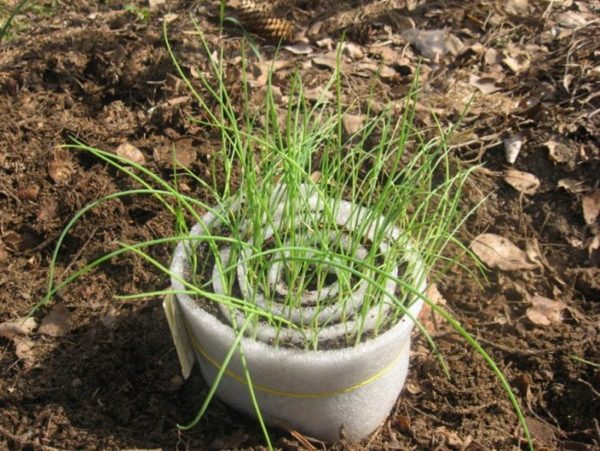

How much do leeks grow from seeds?
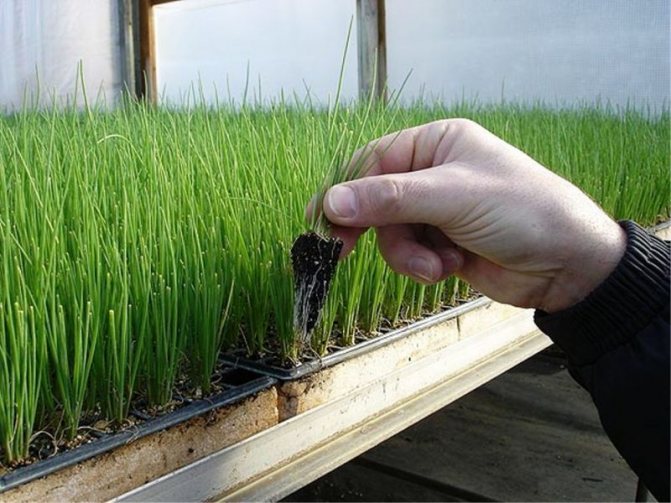

Leek seedlings
In principle, leek seeds sprout pretty quickly. True, for this they need to create the right conditions. This means that they should have enough moisture in the soil, and the temperature in the room should not drop below +18. If all these rules are observed, the seeds will sprout in 5-7 days. If they germinate in not entirely correct conditions, then even 20 days may pass before the first shoots appear.
Seedling varieties
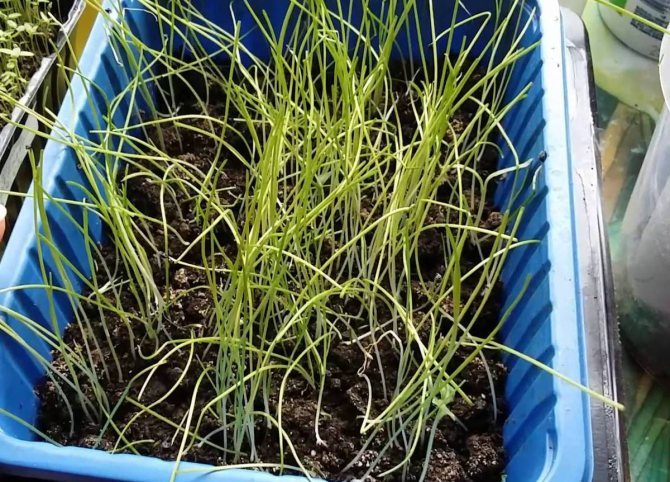

Leeks cannot be called a specific type of bulbous - there are many varieties. Each of them has its own advantages and disadvantages. In general, "pearl onions" are divided into 3 types - early, mid-ripe and late. At the same time, for each of them, some characteristic features are highlighted, which are in no way unchanged in terms of variety. The main differences between plant types can be seen in the comparison table:
| Parameter | Early | Average | Late |
| Ripening terms | After sprouting, the plant reaches full maturity in 100-140 days. | It takes from 140 to 160 days until the onions are fully ripe. | The plant reaches consumer maturity in 180-200 days. |
| Product features | The greens of these varieties can be characterized as delicate and low in fiber. It will not work normally to store such a crop. | The stem is smaller in length and larger in diameter compared to early ripe varieties. Storage duration is limited to 70 days | These varieties need to be grown in a greenhouse or on a windowsill. The fruit part of the plant is larger than the rest. Storage duration reaches 2-3 months |
| Common varieties | Vesta. Columbus. Tango | Goliath. Kilim. Camus | Bandit. Asgeos. Jolant |
Attention! Leeks are propagated by seed. In the southern regions, they can be sown directly into the ground, and for the middle lane and the north, it is better to prepare seedlings in advance.As a feature of late ripening varieties, the accumulation of vitamin C during storage is distinguished. A rise in the level of this substance was noted by a factor of 3.
Picking leek seedlings and care
Experienced gardeners argue that it is not necessary to dive leek seedlings as they perfectly take root in the open field or in a greenhouse without this procedure. But still, as practice shows, as a result, such plants grow weaker, as they are transplanted with a very weak root system. In view of this, it will be better if you do the dive. Moreover, this does not require any special efforts. All you need to do is to disinfect the soil and containers in advance, in which the seedlings will be planted.
After that, moisten the soil in a container with seedlings, but do it as carefully as possible. If you just fill it in, then the tender sprouts will start to fall to one side. After that, carefully remove the plant from the soil, and after straightening its root system, immediately transfer it to a new container. As for care, in this case it will consist in timely watering and maintaining the temperature at an optimal level.
Frequently asked questions
Growing seedlings is often difficult for beginners. Often they have questions about this or that. You do not need to be ashamed of this. Almost every summer resident had similar problems at the beginning of his activity.
What soil to buy for growing seedlings?
To grow seedlings, the soil should be light, with a neutral ph level. You can prepare the soil yourself, but it is best to buy a ready-made substrate in the store. A universal mixture or soil that is positioned as for seedlings is suitable.
You should not overpay for any special specialized substrates. Most likely there will be the same soil mixture.
How can the seeds be stimulated for further growth?
An experienced summer resident who has grown more than one seedlings already knows exactly what drugs should be used. We advise beginners to use the most common means: Gumi, Zircon, Gumat, Agricola, Epin, Energen, etc.
IMPORTANT! Follow the instructions on the package exactly and do not exceed the dosage, otherwise you may "burn" the plants. At the first feeding, it is generally advised to reduce the concentration of the active substance by 2 times.
Why don't the seeds germinate?
Deep seeding is a very common mistake. As a result, after 2 weeks, when shoots should already appear, the summer resident wonders why the seeds did not sprout.
The second popular reason for this problem is the use of old planting material. If you do not want to waste time, effort and money, use "young" seeds. Remember, the miser always pays twice.
The third reason the seeds did not germinate is the lack of stratification. Seeds "sleep" and wake up closer to warm days.
Why are seeds soaked?
Each seed has a dense "shell". To germinate, the seed needs to break through this shell. Soaking softens the shell. In addition, after soaking, you can see which seeds are dummies.
How to harden seedlings?
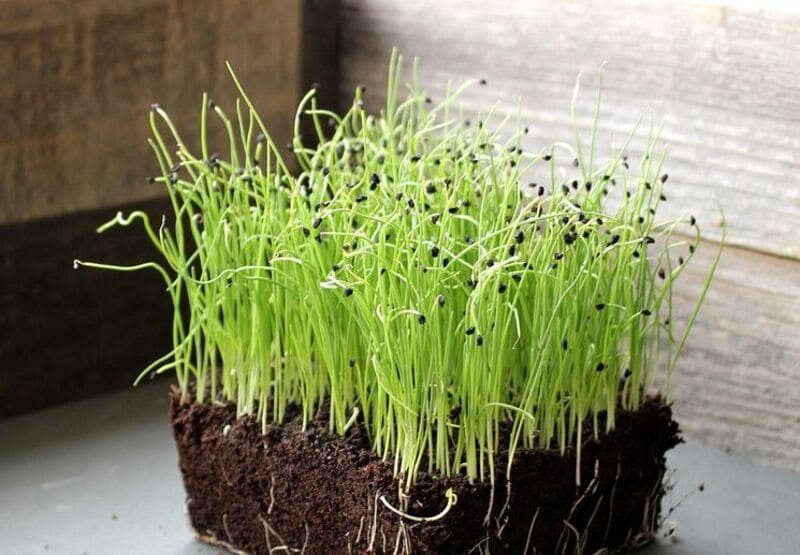

An important trick, which not all novice summer residents know about, is the hardening of seedlings. It is very simple to carry it out.
When there are several weeks left before the estimated date of transplanting seedlings in open ground, take the boxes with seedlings to the balcony. First for 2 hours, then for 6, then for half a day and, finally, for a whole day. The seedlings will get used to new conditions for themselves and by the time of planting they will be already hardened enough to transfer it painlessly.
What to do if leek seedlings are not growing?
Use growth stimulants (Epin, Zircon) and move the boxes closer to sunlight.
After which you can plant leeks, what kind of land does he like?
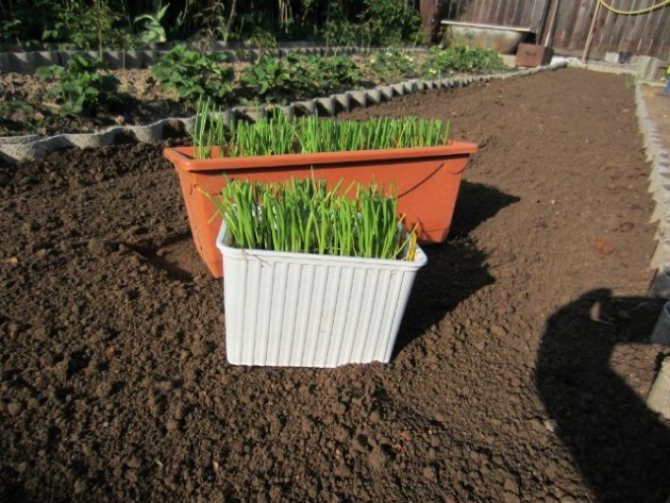

Leek precursors
In principle, leeks are considered an unpretentious plant, therefore, with proper care, they can grow on any soil. But still, if your goal is a good harvest, then remember that it thrives best on light, fertile soils with normal acidity. In view of this, if you know that the soil in your garden is not very good, then fertilize it well with organic fertilizers or superphosphate before planting seedlings. If the acidity of the soil is increased on the site, then liming must be carried out without fail.
It is also very important to consider which plants were growing in the garden before the leeks. So, if you plant this crop on a garden bed where garlic or onions grew in the past season, then you may not wait for a good harvest. Since these crops have the same diseases and pests, as a result, the leek may begin to hurt immediately after you plant it in the garden. Its most ideal predecessors are radishes, cabbage, lettuce, dill and sorrel.
Picking
The transplanting of sprouted shoots takes place in a strict order: 1. Abundant watering of young shoots is necessary for better pulling out of the container along with the soil on the roots. 2. To take out the plant, it is convenient to use a fork or a special spatula. 3. When planting leeks in a row, there should be a free distance of 3-5 cm between the seedlings, or they are transplanted into individual cups. 4. Add additional soil and tamp lightly. 5. Water the plants lightly so that they take root better. 6. Cut the leaves a little.
Recommendation! In order for a healthy root system to form and the plant's stem to thicken, it is necessary to prune the leaves of the shoots every 14 days, leaving only 8-10 cm of leaves.
When to plant leek outdoors: planting time
Planting plants in the ground is a rather serious procedure that should be carried out at the most optimal time. Optimum time means plus day and night temperatures. If the difference between night and day indicators is very large, then the leek will be in constant stress, which will lead to the fact that it will not be able to take root and will start to hurt.
In view of this, plant the crop in the ground when the temperature indicators at night will be at around +12, and during the day the temperature will not drop below +18. Depending on the region, planting leeks in the ground is possible in mid-May, early June.
How to plant leeks in open ground on a garden bed: planting scheme
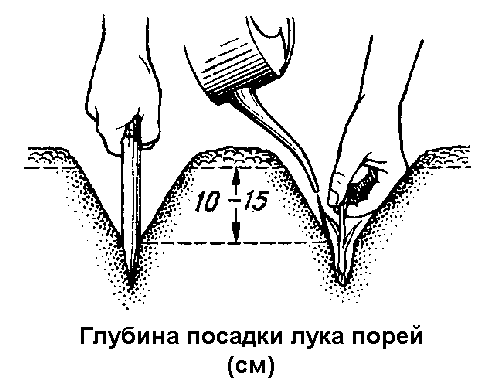

Leek planting scheme
Leeks, like any other vegetable crop, love space. It is needed so that the plant can root well and take the right amount of nutrients from the soil. If you plant seedlings very close to each other, then the plants will grow weak and chase upwards all the time.
All this will lead to the fact that you end up with a very thin leek with a poorly developed white part of the stem. To prevent this from happening, stick to the correct planting pattern. Plant the leeks in rows. The distance between crops in a row must be at least 10 cm, and the distance between rows must be at least 20 cm.
How to sow leeks with seeds in open ground: technology
IMPORTANT: You can use this method of growing leeks in the open field only if you live in a region where nighttime temperatures do not drop below +10 degrees at the end of April and do not drop below +15 in mid-September.
So:
- Choose a site for planting that has the best possible sun exposure throughout the day
- This will contribute to the maximum heating of the soil during the day, which will not allow the leek sprouts to overcool at night.
- Dig up the bed thoroughly. Ideally, the soil should be fluffed to a depth of 20 cm.
- When digging, be sure to add fertilizers to the soil, for example, urea, superphosphate or ordinary compost.
- After the soil is prepared, it will be possible to start sowing seeds (previously prepared)
- To do this, make grooves 7-10 cm deep on the garden bed.The distance between the grooves should be 20 cm
- Moisten the grooves and sow seeds in them
- Sprinkle them with 2 cm of soil, compact it slightly, and moisten the soil with a spray bottle
- After the leek sprouts, be sure to thin it out.
Brief description of cultivation
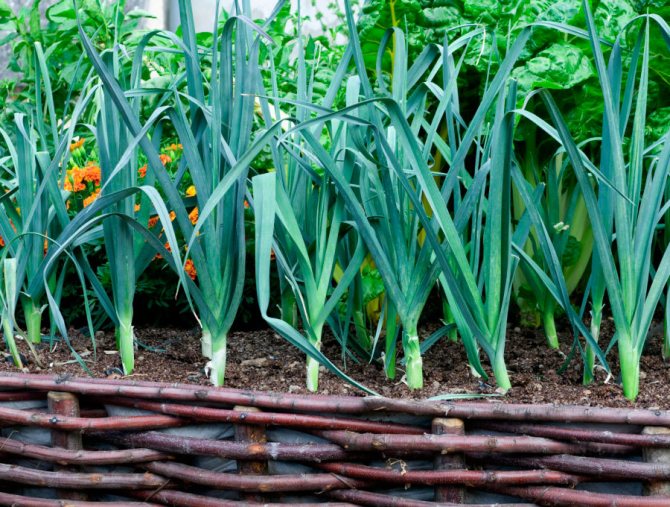

- Landing... Sowing seeds in open soil is carried out in November before winter, and they are sown for seedlings in the last days of February or the first days of March. They are sown in the greenhouse in mid-April, and under the film - in the last days of April. Seedlings are planted in open soil in the first half of May.
- Illumination... Needs lots of bright sunlight.
- Priming... The soil should be nutritious, breathable and neutral.
- Watering... It is necessary to water systematically. After the seedlings are transplanted to the site, they are not watered for several days. Then watering is carried out on average once every 5 days, while 1–1.5 buckets of water are taken per 1 square meter of the plot.
- Fertilizer... During the season, leeks need 3 or 4 feeding, for this they use mineral fertilizers and organic matter. The first fertilization is carried out 20 days after planting seedlings in the garden. From mid-summer until the end of the growing season, the bushes will need to be spud 3 or 4 times, this procedure is mandatory for such a plant.
- Reproduction... Seed.
- Harmful insects... Onion flies.
- Diseases... Rust, peronosporosis, viral mosaic.
- Properties... Such onions are classified as dietary plants, and they also have medicinal properties.
Are leeks afraid of spring frosts?
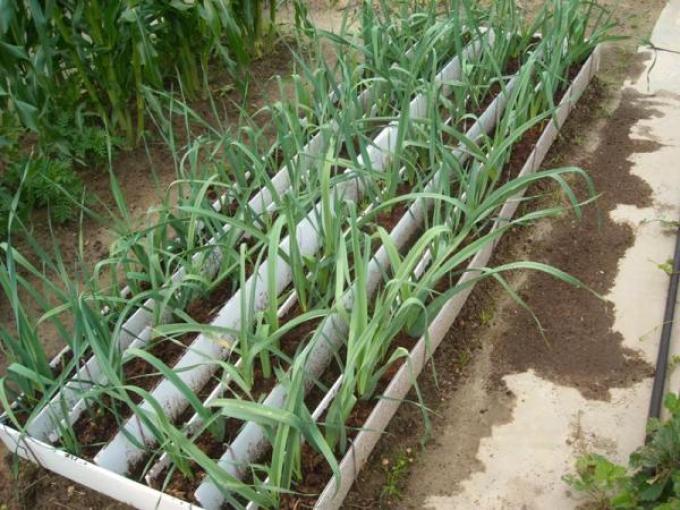

Freezing slows down the development of leeks
In some sources, you can find information that leeks tolerate small frosts quite well. That is why some novice gardeners make a mistake and plant seedlings in open ground, without waiting for positive temperatures at night.
Thus, they are making a big mistake, since this information applies exclusively to mature and mature plants. If, during frosts, leek seedlings are planted in the soil, then it will inevitably begin to hurt. Yes, it is likely that it will not die, but it will begin to grow and develop intensively only after the temperature indicators stop dropping below +12 degrees.
Harvesting and storage of crops
After harvesting, a natural question arises about how to store leeks in winter and under what conditions it will delight with an exotic taste outside the season. There are several ways. The simplest is to place the onions in wooden boxes in the underground or vegetable storage after digging up and cleaning the soil. It is worth paying attention to the fact that it is necessary to avoid getting soil particles into the space between the leaves, which are partially cut off, like the rhizome (leave about 2 cm).
You can also store leeks in the refrigerator. Green tops with deformation and gray, wilted leaves must be removed before winter storage for storage. Old fibers, when cooled, can upset the balance of the entire plant organism. Among the wilted tops, there may be a diseased leaf that can infect the whole onion when a small amount of condensation appears. It is better to store leeks in the refrigerator in vacuum plastic bags, tightly closed boxes of 5-7 pieces. The optimum storage temperature ranges from -1 to +1 degrees. If the leek is not cooled before storage, condensation may form, which will become a favorable breeding ground for fungi and bacteria.
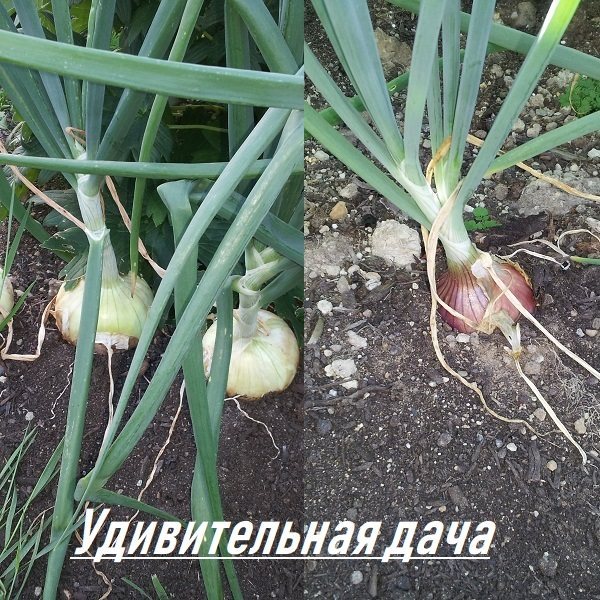

Some store leeks on the balcony until frost.After the temperature drops below -5 degrees, it freezes, although it does not lose its taste and useful properties.
Feeding leeks after planting: fertilizers, folk recipes
Leek seedlings, like any other plant, after planting in the ground, must be fed with special dressings and fertilizers. If this is not done, then the plant will not be able to take root quickly and most likely will not be able to ripen before the first frost. Top dressing is best done in several stages so that the plant receives the amount of nutrients it needs all the time.
Immediately after planting in the ground, feed it with urea. To do this, dilute 10 g of substance in 10 liters of water and pour the leek under the root. After another 14-20 days, add nitrophoska solution to the soil... After that, you need to take a break and just periodically loosen the soil and remove the weeds that have appeared. In addition, you can use the following dressings.
Mullein infusion
- Take 3 kg of rotted mullein and fill it with 7 liters of water
- Mix everything thoroughly and ferment for 7-10 days
- Before use, stir the liquid again and measure out 1 L
- Dilute it in 9 liters of water, and you can feed the leek
Nettle infusion
- Pick up nettles, chop and put in a bucket
- You should have half a bucket of green mass.
- Boil water and pour it over the nettle
- Let it brew for 7 days
- The finished nettle infusion is diluted with water (1:10) and the leek is watered
Leek diseases and their treatment and pest control: a description
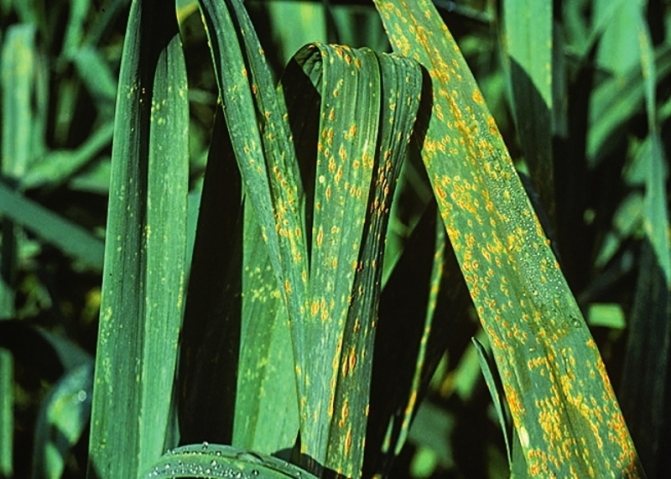

Leek diseases and their treatment
It is believed that leeks, like most members of the Onion family, have fungicidal properties that prevent harmful bacteria and all kinds of fungi from multiplying. Yes, if the plant is properly cared for, then it is highly likely that it will be able to withstand all negative factors. If the culture is weakened, then you will have to fight against fungal and viral diseases and pests.
Leek diseases:
- Powdery mildew. A fungal disease characterized by the appearance of a pale green plaque on the leaves and stem of the leek. Ordinary serum and iodine can help you get rid of this problem. You will need to dilute in 9 l of water 1 l of whey and 10 drops of iodine... The resulting product will need to be sprayed on both sick and healthy plants.
- Neck rot. This disease is dangerous because it remains unnoticed for a long time. Initially, the problem manifests itself as a small dent in the root collar. While the plant is growing, rot does not show itself in any way. But as soon as the leek is removed from the garden and sent for storage, the dent grows, becomes softer and begins to rot. After some time, the leek will completely deteriorate. The best way to fight this disease is prevention. It will be better if you will be disinfect the soil with a weak solution of potassium permanganate.
- Onion rust. This disease manifests itself in the appearance of red, yellow and brown spots on the entire surface of the plant. If you do not start to fight rust in the shortest possible time, then it will very quickly hit absolutely the entire crop. Soda ash and ordinary ash will help you get rid of this problem. Initially, you will need to fill in 5 liters of water 1 kg of ash and let it brew for 3 days. After that, the product is filtered and 2 tbsp is added to it. l soda... Then the amount of the solution is brought to 10 liters and standard processing is carried out.
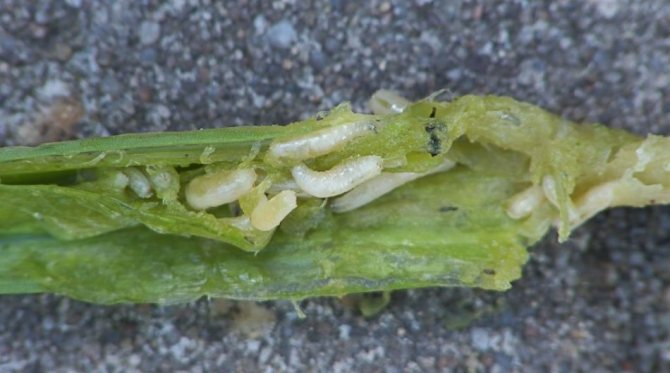

Leek pests
Leek pests:
- Lurker. This pest can prevent leeks from growing throughout the season. Initially, its larvae appear on it, which feed on the juice of young seedlings.If you do not fight them, they transform into black beetles, which go into the soil, but still continue to feed on the fibers of the culture. To combat the pest, you can use ash and tobacco dust... They will need to be mixed in equal parts, and then powder the leek garden with the resulting mixture.
- Onion fly. If your plant is affected by this pest, then you will observe how it gradually turns yellow and withers. After a while, it will begin to rot, while emitting a rather specific smell. In order to quickly get rid of the pest, prepare concentrated broth of wormwood and sprinkle with leek. After the onion fly disappears, be sure to repeat the procedure as a preventive measure.
- Hoverfly... This pest affects the root system and the false bulb of the leek. The hoverfly larva, in order to survive, begins to intensively feed on the fibers of the culture, which leads to the fact that it dies. To avoid the appearance of this pest, be sure to treat the soil with a solution of ash, potassium permanganate and iodine 2-3 times per season. You will need to dissolve in 10 liters of water 1 kg of ash, 10 drops of iodine and 1 g of potassium permanganate, and pour this solution over the leek bed.
Features of growing seedlings
When growing leek seedlings, observe: the mode of watering, feeding, maintain the optimal temperature and the norm of daylight hours. Seedlings dive from common boxes into individual glasses and harden them a week before transferring to open ground.
Watering mode
Leeks need frequent and abundant watering - 2-3 times a week... Young stems are too thin and weak, so watering is done carefully through a sieve or syringe under the root.
Spraying with a spray bottle moisturizes the stems and washes away dust.
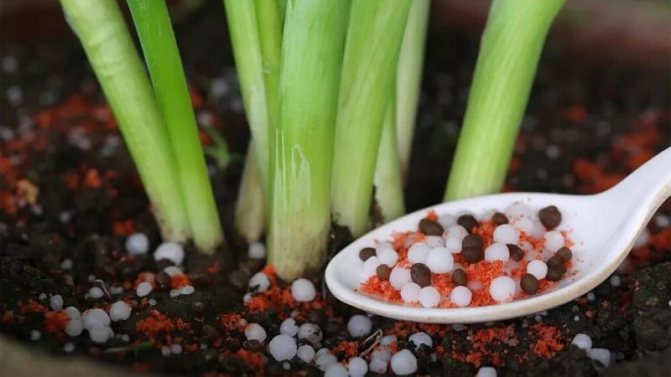

Top dressing
During the growth period seedlings are fed twice:
- two weeks after germination;
- a week before transferring to an open area.
Used as fertilizers ready-made composition "Kemira-universal" or mix the components independently - dissolve 5 g of potassium chloride, 20 g of superphosphate and 10 g of urea in 5 liters of water.
The best feed for leeks is bird droppings.... For its preparation, 500 g of droppings are diluted in 10 liters of water and carefully watered the seedlings under the root, trying not to get on the stems.
Temperature regime and illumination
After the emergence of friendly shoots - this happens after 2-3 weeks - the containers are transferred to a cool place with an air temperature of + 10 ... + 12 ° С at night, and + 15 ... + 17 ° С during the day. In such conditions, the seedlings are kept for a week. Then the air temperature is increased to + 13 ... + 15 ° С at night, + 18 ... + 20 ° С. In this mode, the seedlings are kept until their final transplant into open ground.
Optimal daylight hours - 12 hours... With early sowing in late January - early February, it becomes necessary to supplement the seedlings with a phytolamp, the budget option is LED lamps.
Pick and trim leaves
When sowing seeds in a common container, a mandatory pick is carried out in separate containers. The strongest seedlings are chosen, gently poured in with a spoon and planted in a prepared container with moist soil.
To form the correct bulb earth is periodically poured into the container.
In order for the seedlings to grow strong, pruning the stems is carried out every 14 days, keeping the height at 10 cm. This ensures proper root development and thickening of the stem.
Reference. After 30 days, the seedlings in common containers are thinned out, leaving a distance of 3-4 cm between them.
Hardening
A week before planting in the beds, the seedlings are taken outside for hardening... The containers are left in partial shade. The time is gradually increased, starting from 30 minutes and ending with 12-16 hours.
Why leeks go to the arrow: causes, methods of elimination
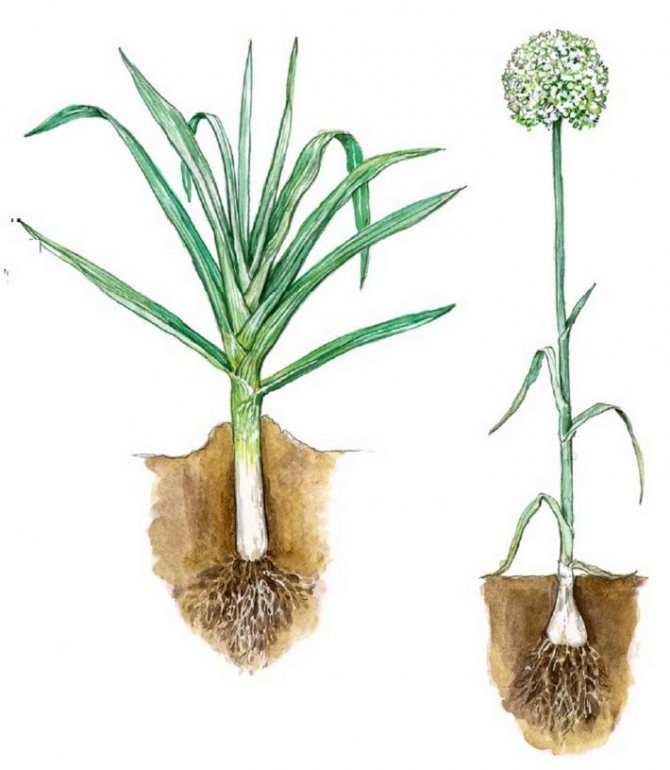

Leek goes to the arrow: reasons
I want to say right away that if you strictly adhere to all the rules for growing leeks, then in the end you can avoid the appearance of such an unpleasant problem. In view of this, try to water the crop in a timely manner, feed it and, of course, do not forget about the regular loosening of the soil and the fight against diseases and pests.
As for the most common reasons for the appearance of an arrow, experienced gardeners most often identify several. And oddly enough, all of them are associated with planting crops in the ground.
The formation of arrows on the leek can be facilitated by:
- The diameter of the bulbs when planted is more than 5 millimeters
- Incorrect storage of planting material
- Sudden changes in temperature indicators
- Low soil temperature during leek planting
As you probably already understood, in order to surely avoid the appearance of arrows on the crop, you just need to choose the right planting material and plant it on the garden bed only when the soil warms up enough.
Leeks: is it possible to leave it before the winter
In principle, leeks are a two-year-old plant, so if desired, they can be left to winter in the garden. True, you should take into account that the culture will normally overwinter only if you live in a region where spring comes early, and in winter the temperature does not drop to abnormal rates. It is also worth remembering that after wintering, the plant will begin to intensively form a peduncle with seeds. In view of this, in order to avoid the appearance of arrows, you will need to cut off the plants immediately after the snow melts.
Planting leeks before winter: description
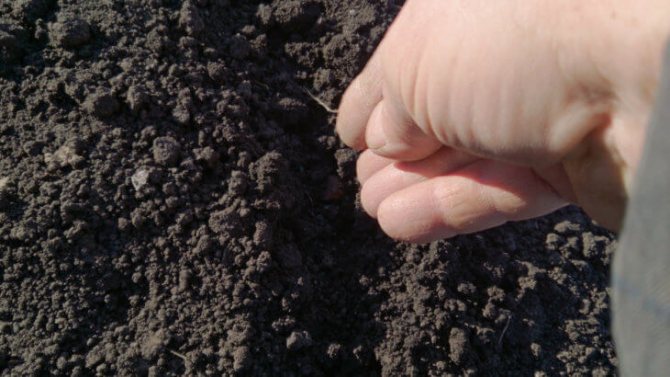

Planting leeks before winter
If you don't want to mess around with growing leeks in the spring, then you can try sowing seeds in the soil in late fall. If you do everything right, they will successfully overwinter in the soil, and very early in the spring they will delight you with fresh and juicy greens.
Landing technology:
- Start preparing a garden for sowing seeds in September
- Clean it from weeds, and be sure to disinfect the soil with ash or potassium permanganate
- Dig up the soil to a depth of at least 20 centimeters
- Around mid-November, lightly fluff the bed and make shallow grooves (at a distance of 15-20 cm from each other)
- Add top dressing to them and boldly sow seeds
- Sprinkle them with a layer of peat and leave to winter
- In the spring, make sure that the garden is not left without snow very early
- It can promote early germination of leeks.
- To prevent this from happening, you can additionally throw snow at the end of winter.

